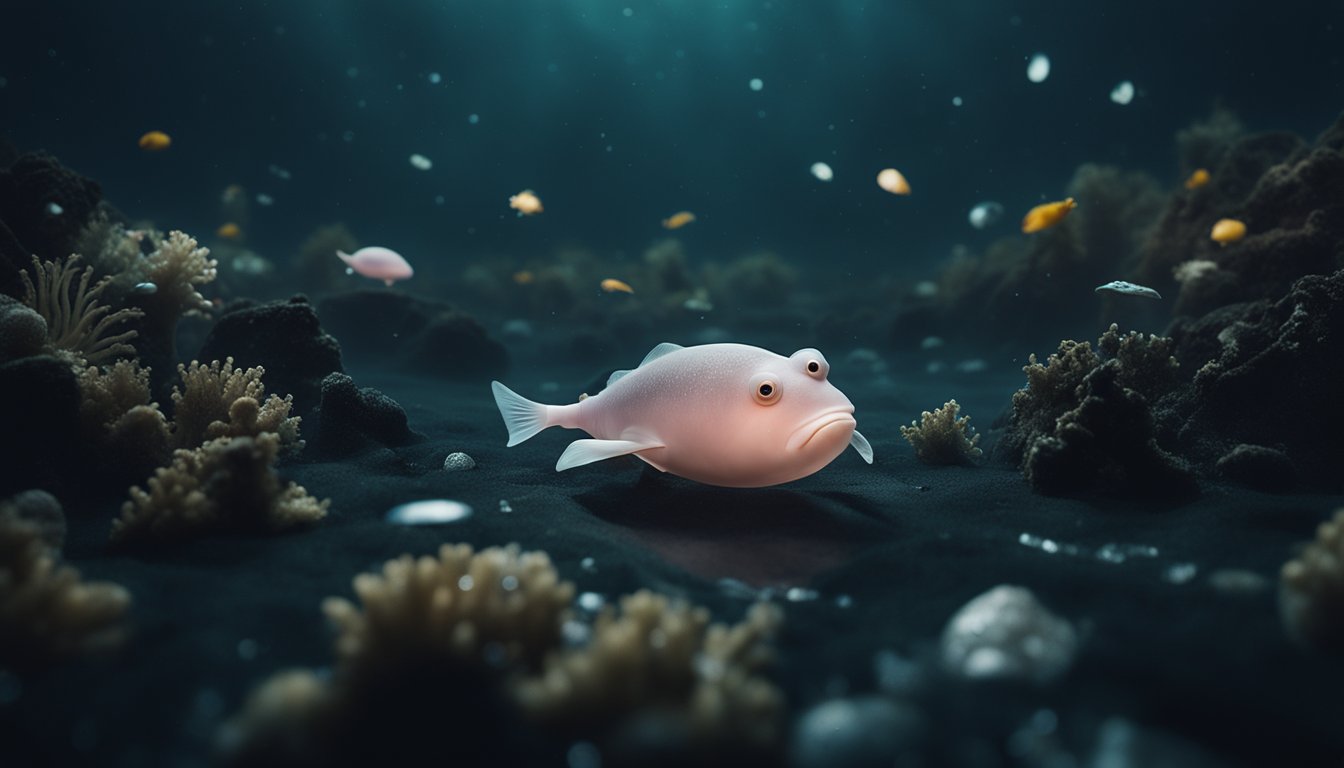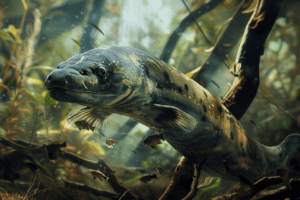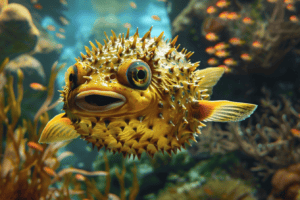The blobfish has become a bit of an internet sensation in recent years, thanks to its unique appearance.
Often referred to as the “world’s ugliest fish,” the blobfish has a distinctive, droopy appearance that has captured the imagination of many.
However, despite its unusual looks, the blobfish is a fascinating creature with a unique life that is often misunderstood.

In this article, we’ll take a closer look at the blobfish and explore some of the misconceptions that surround this unusual fish.
We’ll delve into its habitat, behavior, and physical characteristics, and examine the important role that the blobfish plays in its ecosystem.
Through this exploration, we hope to provide readers with a better understanding of this fascinating creature and encourage them to see beyond its unusual appearance.
The Mysterious Blobfish

Defining the Blobfish
The Blobfish is a unique-looking fish that has become an internet sensation in recent years.
It is known for its unusual appearance, which is often described as “ugly” or “disgusting.” However, despite its unappealing looks, the Blobfish is an important part of the ecosystem and has a fascinating life story.
The Blobfish (Psychrolutes marcidus) is a deep-sea fish that belongs to the family Psychrolutidae.
It is found in the waters off the coast of Australia, New Zealand, and Tasmania, at depths of up to 1,200 meters.
The Blobfish is a bottom-dwelling fish that spends most of its life on the ocean floor.
The Blobfish is a soft-bodied fish with a gelatinous appearance. It has a large head and a rounded body, with no visible scales or fins.
The Blobfish’s body is covered in a layer of mucus, which helps it to survive in the extreme pressure and cold temperatures of the deep sea.
Natural Habitat
The Blobfish lives in one of the most extreme environments on Earth.
It inhabits the deep-sea, where the pressure can be up to 80 times greater than at the surface.
The temperature can also be near freezing, and there is no light to support photosynthesis.
The Blobfish is adapted to this harsh environment in several ways.
Its soft body allows it to withstand the pressure of the deep sea, while its gelatinous appearance helps it to conserve energy.
The Blobfish also has a unique feeding strategy.
It feeds on small invertebrates that live on the ocean floor, using a suction-like mouth to capture its prey.
Despite its unusual appearance and extreme habitat, the Blobfish is an important part of the deep-sea ecosystem.
It plays a crucial role in the food chain, providing food for larger predators such as sharks and rays.
In conclusion, the Blobfish may look strange and unappealing, but it is a fascinating and important species.
Its unique adaptations and role in the ecosystem make it a valuable part of the natural world.
Misconceptions and Truths

The Ugliest Animal Myth
The blobfish is often referred to as the “world’s ugliest animal.” This myth is perpetuated by photographs of the fish taken out of its natural habitat, where it appears bloated and unappealing.
However, in reality, the blobfish is perfectly adapted to its deep-sea environment, where the pressure is several times higher than at the surface.
The blobfish has a gelatinous body that allows it to float effortlessly above the seafloor, conserving energy.
Its fleshy appearance is due to the lack of a swim bladder, which most fish use to control their buoyancy.
The blobfish has evolved to rely on its jelly-like flesh and low-density muscles to stay afloat.
Conservation Status
Contrary to popular belief, the blobfish is not endangered.
It is listed as “Data Deficient” by the International Union for Conservation of Nature (IUCN), which means there is not enough information to determine its conservation status.
The blobfish is not directly targeted by fisheries, but it often gets caught as bycatch in deep-sea trawling operations.
The blobfish’s deep-sea habitat is one of the most unexplored and understudied environments on Earth.
Scientists are still discovering new species and learning about the unique adaptations of the creatures that live there.
It is crucial to protect these habitats from human activities that can cause irreversible damage to the delicate balance of the ecosystem.
In conclusion, the blobfish is a fascinating and misunderstood creature that deserves our attention and respect.
By dispelling myths and learning the truth about this fish, we can appreciate the wonders of the natural world and work towards its conservation.
Blobfish Biology
The blobfish is a unique-looking fish that lives in the deep waters off the coast of Australia, Tasmania, and New Zealand.
Despite its somewhat unappealing appearance, the blobfish has a fascinating biology that is worth exploring.
Diet and Behavior
Blobfish are bottom dwellers, meaning they spend most of their time on the ocean floor.
They are opportunistic feeders, meaning they eat whatever prey is available to them.
Their diet consists mainly of crustaceans, mollusks, and smaller fish.
They are not very active swimmers and instead rely on their suction-cup-like mouth to catch their prey.
Blobfish are solitary creatures and do not form schools or groups. They are not aggressive towards humans and are generally harmless.
However, they are often caught unintentionally by commercial fishing nets, which can be fatal for them.
Reproduction and Lifespan
Blobfish reach sexual maturity at around 4-5 years of age. They reproduce by laying eggs, which are fertilized externally by the male.
The eggs are then left to develop on their own.
The female can lay up to 100,000 eggs at a time, but only a small percentage of these will survive to adulthood.
Blobfish have a relatively long lifespan for a fish, living up to 130 years.
This is due in part to their slow metabolism and the cold temperatures of their deep-sea habitat.
In conclusion, the blobfish may not be the most attractive fish in the ocean, but it has a unique biology that is worth exploring.
Its diet and behavior, as well as its reproduction and lifespan, offer insight into the fascinating world of deep-sea creatures.
Human Impact and Blobfish

Fishing and the Environment
The blobfish is a deep-sea fish that lives in the waters off the coasts of Australia, Tasmania, and New Zealand.
Unfortunately, it has become a victim of overfishing. As a result, the population of the blobfish has decreased significantly in recent years.
Fishing trawlers, which drag large nets along the ocean floor, are one of the main threats to the blobfish.
These nets are not selective and can catch any marine life in their path, including the blobfish.
The blobfish is often caught unintentionally and then discarded as bycatch.
Furthermore, the blobfish is a slow-moving fish that does not reproduce quickly. This makes it particularly vulnerable to overfishing.
The decline in the population of the blobfish could have serious consequences for the ocean ecosystem.
Public Perception and Media
The blobfish has been called the “world’s ugliest fish” by the media.
Its unusual appearance has made it the subject of many jokes and memes on the internet.
However, this negative attention has had a serious impact on the blobfish’s reputation and conservation efforts.
Many people believe that the blobfish is an unimportant and ugly fish that does not deserve protection.
This misconception has made it difficult for conservationists to raise awareness about the blobfish’s plight.
In reality, the blobfish plays an important role in the deep-sea ecosystem.
It feeds on smaller fish and invertebrates and is itself a source of food for larger predators.
The blobfish’s unique appearance is also a result of its adaptation to the extreme pressures of the deep sea.
It is important to recognize the value of the blobfish and protect it from further harm.
By raising awareness about the blobfish’s role in the ecosystem and the threats it faces, we can work towards a more sustainable future for this misunderstood fish.
Frequently Asked Questions

What unusual features do blobfish have that differ in deep sea conditions versus at the surface?
Blobfish are known for their unusual appearance, which is a result of the extreme pressure in their deep-sea habitat.
At the surface, blobfish look quite different, as they lack the pressure that gives them their characteristic shape.
In deep-sea conditions, blobfish have a gelatinous body and a large head with a bulbous nose.
They also have a unique adaptation that allows them to swallow prey whole, as their bodies are too soft to chew.
How does the appearance of a blobfish change when it is no longer in its natural deep-sea habitat?
When a blobfish is brought to the surface, it undergoes a significant change in appearance.
Its body becomes compressed due to the lack of pressure, and it loses its distinctive shape.
The blobfish’s skin also becomes damaged, making it look even more unappealing than it already does.
Where do blobfish typically live, and what is unique about their habitat?
Blobfish are found in the deep waters off the coasts of Australia, New Zealand, and Tasmania.
Their habitat is unique because it is one of the most extreme environments on Earth.
The deep sea is characterized by low temperatures, high pressure, and complete darkness.
Blobfish have adapted to this environment by developing a gelatinous body that allows them to float effortlessly in the water.
What are the early life stages of a blobfish like, and how do they grow?
Blobfish eggs are laid in nests on the ocean floor, where they are guarded by the male until they hatch.
The larvae that emerge from the eggs are free-swimming and are carried by ocean currents.
As they grow, they develop the characteristic shape of the blobfish.
It takes several years for a blobfish to reach maturity, and they can live for up to 130 years.
Is the blobfish population at risk, and what factors contribute to their conservation status?
The blobfish population is currently considered vulnerable due to overfishing and habitat destruction.
Blobfish are often caught as bycatch in deep-sea trawling nets, and their habitat is threatened by deep-sea mining and oil exploration.
Conservation efforts are underway to protect the blobfish and its habitat.
What forms the main part of a blobfish’s diet in the deep sea?
Blobfish are opportunistic predators, meaning they will eat whatever prey is available.
Their diet consists of small fish, crustaceans, and other invertebrates that live on or near the ocean floor.
They are able to swallow prey whole due to their unique adaptation that allows them to expand their stomachs.









